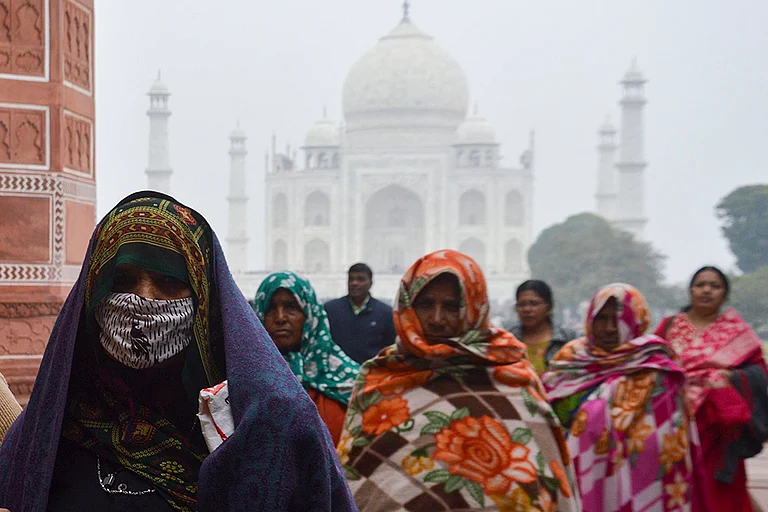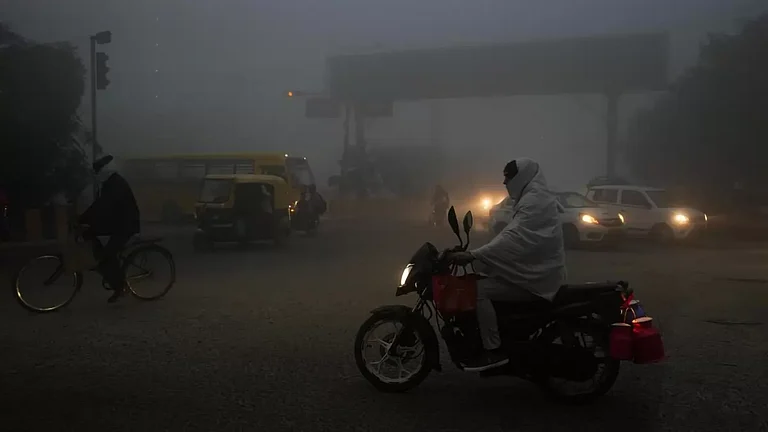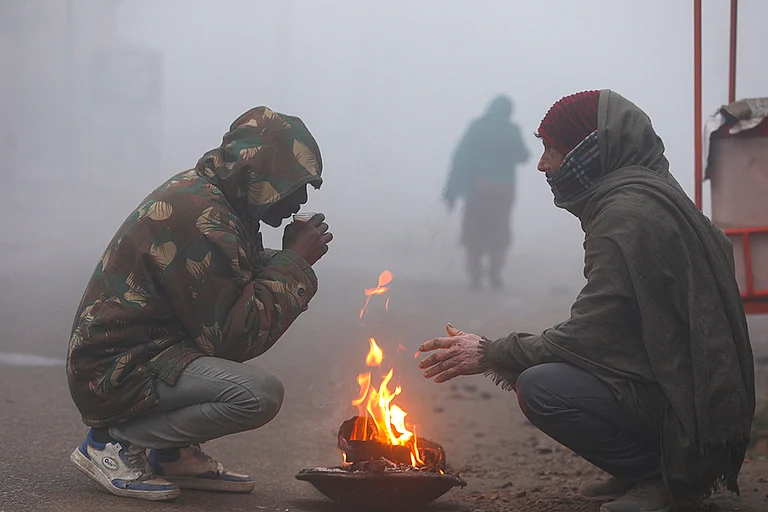Failed winter rains, relentless monsoon breaking a 102-year-old record, and snowfall in April this year amidst the India Meteorological Department’s (IMD) forecast of a heat wave in the country should worry the hill states of Himachal Pradesh and Uttarakhand, just ahead of the next monsoon—which is already predicted to be ‘‘above normal’’.
The weekend saw fresh snowfall in the higher hills. Thunderstorms, hail and unseasonal rains struck the rest of the mountain region, uprooting trees and damaging crops ahead of the upcoming fruit season.
Despite extreme weather events—which are fatal and a dire threat to livelihoods—hardly anyone on the election campaign trail is talking about the disastrous impacts of climate change in the Himalayan region, which is particularly vulnerable and ecologically sensitive. The two hill states that share similarities of terrain and environmental conditions are also gifted with rich natural resources—rivers, forests and minerals. However, increased frequency and intensity of extreme weather events like droughts, landslides, flash floods, melting of glaciers due to rising temperature and global warming have made survival challenging for the residents of these states. The local communities’ dependency on natural resources has also been severely affected.
Anoop Nautial, a Dehradun-based social activist says, “Uttarakhand is highly sensitive to natural disasters just like Himachal Pradesh. The changing cycle of climate change is impacting the overall ecosystem of development, health and agriculture. Mega disasters like Kedarnath, Chamoli and Silkyara tunnel, and the environmental crisis at Joshimath are just the tip of the iceberg. Migration turning the entire hill landscape into ‘ghost villages’ is also linked to these changes.”

He says it is unfortunate that the ruling party has chosen to ignore critical issues that concern people’s lives: climate change and disaster management. Opposition parties and prominent independents have also not lent their voices to these grim realities. This Lok Sabha election remains a non-event as far as the voters are concerned because the question of how political parties would address these pressing issues is completely missing from the ongoing electoral discourse.
Both Uttarakhand and Himachal Pradesh are constantly struggling with natural disasters and landslides. The impact of the climate changes on Himachal Pradesh’s Rs 5,500 crore apple industry has plunged the farming sector into a major crisis.
Freak weather conditions, declining pattern of snow, high temperature and lack of timely rains are some of the factors leading to frequent crop failures, and gradual shortfall in apple production yearly.
Says Prakash Thakur, former vice-chairman Himachal Pradesh Horticulture Produce Marketing and Processing Corporation (HPMC), “Conditions are changing fast. It is quite clear that global warming has had a profound impact on apple farming in Himachal. Since the 1980s, apple growers have been feeling the impact of erratic weather patterns. In 2023, there was the severe impact of the unfavourable weather pattern and missed snowfall. The continuous rains during 1982 and 1983 were instrumental in creating a congenial environment for apple scab. Farmers lost their entire apple crop because no one had a clue about this disease."
Sanjay Chauhan, former Mayor of Shimla, says that climate change and the resultant warm winters have been seriously impacting Himachal’s apple crop’s quantity and quality. Over the last two to three decades, production has gradually come down by about 30 per cent.
Last year’s monsoon—one of the worst incidents of extreme weather—left a trail of death and devastation across the state, particularly in Kullu and Mandi. The rains broke a 102-year-old record and landslides destroyed national highways, bridges and four-lanes while floods washed away infrastructure and properties. Over 500 deaths and losses to the tune of Rs 10,000 crore were reported.
At election time, the ruling party—the Indian National Congress (INC)—and the opposition, the BJP, are busy fighting it out as to who failed at the time of crisis and did not do enough to help the disaster-affected families.
“The centre neither declared the disaster as a national calamity nor sanctioned any financial package. I met Prime Minister Narendra Modi and Home Minister Amit Shah. BJP’s national president J P Nadda also did not come to our rescue. Yet, we mobilised a Rs 4500 crore relief package and raised money through the CM relief fund from the public,” says Himachal Chief Minister Sukhwinder Singh Sukhu.
The BJP, on the other hand, accuses the Congress government of not using a Rs 1,800 crore grant to help the victims.
As per an IMD report, 26 cloudbursts happened in Kullu in July 2023, followed by eight in Shimla, five in Kinnaur, two each in Chamba and Mandi and one each in Lahaul, Spiti and Solan. In August, four cloudbursts happened in Mandi district, followed by two in Sirmaur and one in Solan. There is no early warning still in place in the state to alert the local population and the administration. IMD data reveals that about 61 per cent of the total normal rainfall from June 1 to September 30, 2023 was recorded in the month of July .The total normal rainfall from June 1 to September 30 was 734.4 mm of which 448.1 mm was recorded in July alone.
Himachal Pradesh received 884.8 mm of rain against normal rainfall of 734.4 mm, an excess of 20 per cent since during the monsoon season in the same period.
As many as 45 flash floods, including 26 in Kullu district alone occurred during July and seven during August. The 448.9 mm rainfall recorded in July was the highest in the state since 1980. During the period 1901 to 2023, the state received the highest rainfall of 1314.6 mm in 1922 and the 36th highest rainfall during the current monsoons, the IMD analysis revealed. In July as many as 47 heavy rainfall events were recorded in Shimla and 25 such incidents were reported in Sirmaur while Mandi also experienced 22 heavy rainfall events.
It is not the excessive rainfall (63 per cent above normal) during April 2023 that is worrying the people of Himachal Pradesh. It is the gradual change in weather patterns they have been witnessing in recent years—unusual rainfall, hail, snow, thunderstorms, high velocity winds and drop in temperature.
Suresh Attri, a principal scientist at the Himachal Pradesh Department of Environment says the impact of climate change on the state should alarm everyone and policy solutions based on scientific studies must be implemented. “For example, the soil moisture deficit index (SDMI) of Shimla, calculated over 30 years of simulated soil moisture data from the baseline (1980-2010), reveals that by mid-century (2050) and end-century (2100), drought-like conditions will increase.”
He adds, “We can safely reach the conclusion that Shimla will be highly exposed to rainfall variability, extremely wet days, dry days, flood discharges, drought weeks and sensitivity to heat stress, besides rising seasonal crop water stress by 2050 and onwards.”
Major political parties talk about climate change in their election manifestos. But what concrete steps will they actually take at the at-risk hill states? The BJP’s manifesto states, “We will continue to protect and preserve the unique ecological balance of Bharat's hill states through sustainable development initiatives. We will work with state governments and local bodies to prepare a special master plan to maintain their pristine beauty and biodiversity, taking into account the local geography, culture and traditional practices, for the balanced development of hilly areas.”
The Congress manifesto also mentions the need to address the issues of climate change and disaster management. It says, “The Congress re-affirms its profound commitment to rapid, inclusive and sustainable development, and to protect its ecosystems, local communities, flora and fauna. The National Action Plan on Climate Change was prepared under the leadership of Prime Minister Manmohan Singh. The Congress will appoint a high-level committee to study the issue of landslides in the hill districts, evolve measures to prevent landslides and ensure citizens’ safety.”





























